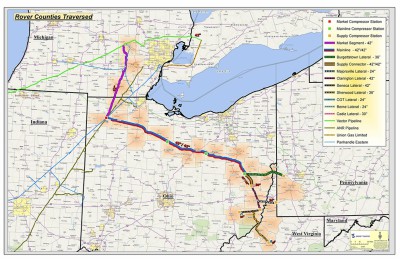ETP says US drilling ban unlikely to delay Ohio gas pipeline
(Reuters) -- Completion of the Rover pipeline, the biggest natural gas pipe under construction in the United States, is not expected to be delayed by a US federal order to stop new drilling to install pipe, Energy Transfer Partners LP said on Thursday.
 |
| Photo Courtesy of Energy Transfer Partners LP. |
The company spilled more than 2 MM gal of drilling fluid—mostly water and clay—in Ohio wetlands in April during construction of Rover, prompting regulators to halt drilling in certain areas. The line, once finished, will have the ability to carry enough gas to supply 15 MM US and Canadian homes.
It is one of a network of pipelines being built to boost production in the Marcellus and Utica shale regions located largely in Pennsylvania and Ohio, the biggest source of US gas that comes from fracking.
"We need to slow down the rush to build new pipelines and consider what safety really means," said Lynda Farrell, executive director of the Pipeline Safety Coalition, a Pennsylvania-based nonprofit that advises landowners on how to make informed decisions on pipeline projects. She noting ETP has had 18 incidents involving mud spills since starting construction of Rover in March.
ETP is best known as the operator of the Dakota Access crude pipeline from North Dakota to Illinois, the object of stiff opposition from the Standing Rock Sioux tribe. Dakota Access, which suffered a small leak in April, is expected to enter service in June.
The drilling ban will remain in place until US Federal Energy Regulatory Commission (FERC) staff authorizes the company to start again. It does not prevent ETP from finishing drilling activities already started or other non-drilling construction.
ETP said it does not expect FERC's action to affect the project timeline.
"At this time, we do not anticipate this will change our in-service dates, and we do not have any updates in the total project cost to report," Alexis Daniel, a spokeswoman for ETP said in an email.
ETP has said the $4.2 B pipeline, which stretches from Pennsylvania to Ontario, Canada, will have the capacity to transport 3.25 Bcf of gas. It was scheduled to enter service in two phases in July and November. One Bcf is enough gas for about 5 MM US homes.
Concern that the ban could delay the start of the pipeline helped lift natural gas futures by about 2% on both Wednesday and Thursday, traders said.
FERC said in a letter to ETP that it has serious concerns regarding the magnitude of the wetlands incident, its environmental impacts, the lack of clarity regarding the underlying reasons for its occurrence and the possibility of future problems.
FERC said ETP cannot conduct any new horizontal directional drilling activities until it complies with certain measures to help prevent spills. ETP's Daniel said construction continues along the route except for the specific drilling sites specified by FERC.
Analysts at FBR, an investment bank, said in a note that FERC's additional requirements should be manageable but tend to lead to higher costs and more frequent delays.
The spill occurred during drilling under the Tuscarawas River in Stark County, Ohio, and covered about 6.5 acres of wetlands.
The Ohio Environmental Protection Agency last week fined ETP $431,000 to resolve numerous water and air pollution violations, including what the state called the release of "several million gallons of bentonite slurry" into a wetland.
"Energy Transfer (Rover) has repeatedly violated Ohio's environmental laws and standards as it relates to inadvertent returns, discharges to waters of the state, storm water issues, and open burning regulations," said James Lee, spokesman for the Ohio EPA.
FERC said it was requiring Rover to immediately obtain independent third-party contractor proposals to further analyze all drilling activity at the Tuscarawas River drilling site.
Reporting by Scott DiSavino; Editing by David Gregorio and Steve Orlofsky

- ADNOC Gas awards $2.1 B in contracts to enhance LNG supply infrastructure
- U.S. Department of the Treasury releases final rules for clean hydrogen production tax credit
- Nicor Gas celebrates its first renewable natural gas interconnection
- EnviTec Biogas looks to expand biogas production into the U.S.
- AGDC and Glenfarne to develop $44-B Alaska LNG project



Comments